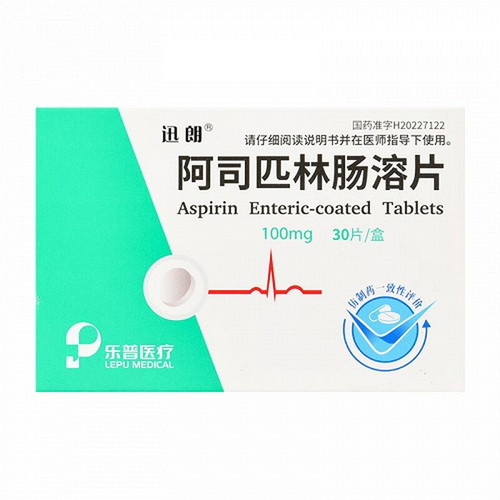Product Overview
[Drug Name]
Generic Name: Enteric-Coated Aspirin Tablets
Trade Name: Ogina Enteric-Coated Aspirin Tablets 100mg x 24 Tablets
[Main Ingredients]
The main ingredient of this product is aspirin. Its chemical name is 2-(acetoxy)benzoic acid.
[Properties]
This product is an enteric-coated tablet that appears white after removal of the coating.
[Indications/Main Functions]
Inhibits platelet adhesion and aggregation in the following conditions: 1. Unstable angina (heart pain caused by obstructed coronary blood flow); 2. Acute myocardial infarction; 3. Prevention of recurrent myocardial infarction; 4. Post-operative arterial surgery (post-operative arterial surgery such as transaortic coronary artery bypass grafting, PTCA); 5. Prevention of transient ischemic attack (TIA) and cerebral infarction after the onset of early symptoms (such as transient paralysis of facial or arm muscles or transient blindness).
【Specification】
100mg*24 tablets (Ojina)
【Usage and Dosage】
Oral. Children aged 8 to 14 years, 1 tablet at a time; children over 14 years old and adults, 1 to 2 tablets at a time; if fever or pain persists, the drug can be repeated once every 4 to 6 hours, not more than 4 times in 24 hours.
【Adverse Reactions】
1. Common gastrointestinal reactions include nausea, vomiting, upper abdominal discomfort or pain. 2. Less common or rare reactions include (1) gastrointestinal bleeding or ulcers, manifested as bloody or tarry stools, severe stomach pain or vomiting of bloody or coffee-like substances, which are more common in patients taking large doses. (2) Bronchospasm allergic reaction, manifested as dyspnea or asthma. (3) Skin allergic reaction, manifested as rash, urticaria, itchy skin, etc. (4) Hematuria, dizziness and liver damage.
【Contraindications】
1. Pregnant and lactating women are prohibited from using this product. 2. This product is contraindicated in patients with asthma, nasal polyposis syndrome, or allergies to aspirin or other antipyretic analgesics. 3. This product is contraindicated in patients with hemophilia, thrombocytopenia, or active ulcer disease.
[Drug Interactions]
1. This product should not be used concomitantly with anticoagulants (such as dicoumarol, heparin) or thrombolytics (streptokinase). 2. Antacids such as sodium bicarbonate can increase urinary excretion of this product, decreasing blood concentrations, and should not be used concomitantly. 3. This product can increase gastrointestinal adverse reactions when used concomitantly with glucocorticoids (such as dexamethasone). 4. This product can enhance the effects of oral hypoglycemic agents and methotrexate and should not be used concomitantly. 5. Concomitant use with other medications may result in drug interactions. Please consult your physician or pharmacist for details.
[Precautions]
1. This product is a symptomatic treatment. For fever relief, use for no more than 3 consecutive days, and for pain relief for no more than 5 days. If symptoms persist, consult a physician or pharmacist. 2. Do not take with other medications containing antipyretics and analgesics (such as certain combination cold medicines). 3. The tablet must be swallowed whole; do not crush or dissolve it before taking. 4. Elderly and infirm patients should use this product under the guidance of a physician. 5. Do not consume alcohol or beverages containing alcohol while taking this product. 6. Use with caution in patients with gout, impaired liver and kidney function, heart failure, epistaxis, menorrhagia, or a history of hemolytic anemia. 7. Use with caution in children with fever and dehydration. 8. In case of overdose or serious adverse reactions, seek medical attention immediately. 9. Do not use if you are allergic to this product. Use with caution if you have allergic reactions. 10. Do not use if the properties of this product change. 11. Keep this product out of reach of children. 12. Children must be supervised by an adult when using this product. 13. If you are currently using other medications, consult your physician or pharmacist before using this product.
[Pediatric Use]
Pediatric patients, especially those with fever and dehydration, are susceptible to toxic reactions. Use of this product in children with acute febrile illnesses, especially those with influenza and chickenpox, may be associated with the development of Reye's syndrome, a condition rarely seen in China.
[Elderly Use]
Elderly patients are susceptible to toxic reactions due to decreased renal function.
[Overdose]
Manifestations of overdose: 1. Mild, also known as salicylic acid reaction, is more common in patients treated for rheumatic conditions with this product. Symptoms include headache, dizziness, tinnitus, deafness, nausea, vomiting, diarrhea, drowsiness, mental confusion, sweating, rapid breathing, thirst, involuntary movements of the hands and feet (more common in the elderly), and visual impairment. 2. Severe, including hematuria, convulsions, hallucinations, severe mental confusion, dyspnea, and unexplained fever. Mental and respiratory disturbances are more pronounced in children.
[Pharmacology and Toxicology]
This product can inhibit prostaglandin synthesis and has antipyretic and analgesic effects.








